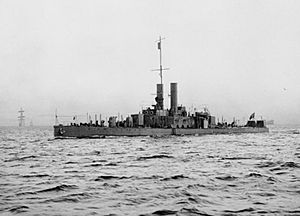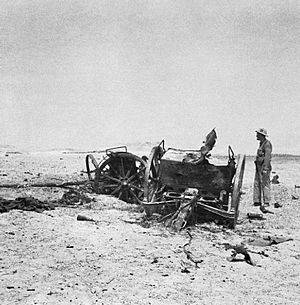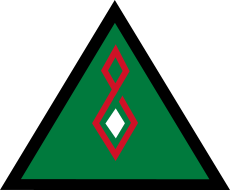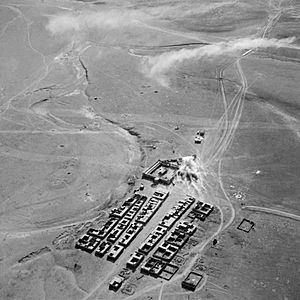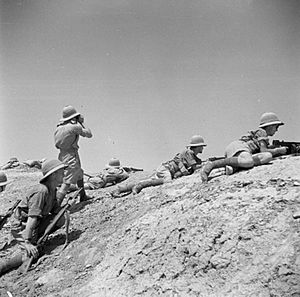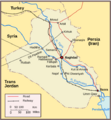Anglo-Iraqi War facts for kids
Quick facts for kids Anglo-Iraqi War |
|||||||
|---|---|---|---|---|---|---|---|
| Part of the Second World War (Mediterranean and Middle East theatre) | |||||||
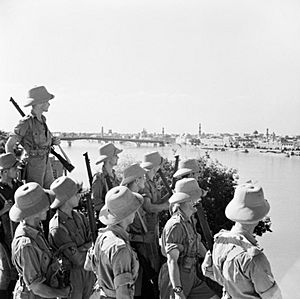 British soldiers at Baghdad, 11 June 1941 |
|||||||
|
|||||||
| Belligerents | |||||||
|
Military support: |
||||||
| Commanders and leaders | |||||||
| Strength | |||||||
| 1 infantry division 2 brigade groups 100+ aircraft |
4 divisions 30,000 troops 116 Iraqi aircraft (50–60 serviceable) 21–29 German aircraft 12 Italian aircraft |
||||||
| Casualties and losses | |||||||
| Casualties slight At least 200 killed 28 aircraft |
500 killed Most of the serviceable Iraqi aircraft 19 German aircraft 3 Italian aircraft |
||||||
The Anglo-Iraqi War was a short but important military conflict during World War II. It happened in May 1941. The war was fought between the United Kingdom (and its allies) and the Kingdom of Iraq. Iraq was led by Rashid Ali, who had taken power with help from Nazi Germany and Fascist Italy.
Before this war, Britain had a lot of influence in Iraq. This was because of a treaty signed in 1930. Many Iraqis, including Rashid Ali, didn't like this treaty. In April 1941, Rashid Ali led a coup and took control. He became friends with Germany and Italy, which worried the British. Iraq was important to the Allies because it was a land bridge between British forces in Egypt and India.
The British decided to act. They launched air attacks on Iraq starting May 2nd. The war ended quickly with a British victory. Rashid Ali's government fell, and the British re-occupied Iraq. The previous leader, Prince 'Abd al-Ilah, who was a British ally, returned to power. This war greatly increased Britain's power in the Middle East.
Contents
Understanding the Background
Iraq's History with Britain
Iraq was once called Mesopotamia. It was controlled by Great Britain under a special agreement from the League of Nations. This lasted until 1932, when Iraq became officially independent.
However, before independence, Britain made Iraq sign the Anglo-Iraqi Treaty of 1930. This treaty allowed Britain to keep military bases in Iraq. It also let British forces move freely through the country. Many Iraqis didn't like these rules. They felt Iraq was still under British control.
After 1937, most British troops left Iraq. The Iraqi government became responsible for its own safety. But the British Royal Air Force (RAF) kept two important bases. These were RAF Shaibah near Basra and RAF Habbaniya between Ramadi and Fallujah. These bases protected British oil interests. They were also key stops for air travel between Egypt and India.
When World War II started, RAF Habbaniya became a training base. It was protected by British armored cars and local Assyrian troops. These troops were called the Iraq Levies.
The Coup in Iraq
In September 1939, Iraq broke off ties with Nazi Germany. In March 1940, Rashid Ali, who was against British influence, became Prime Minister. He secretly talked with German officials.
When Italy joined the war in June 1940, Iraq did not break ties with them. The Italian office in Baghdad became a center for German and Italian messages. It also helped spread anti-British feelings. A religious leader, Amin al-Husseini, who had fled from British-controlled Palestine, helped with this.
In January 1941, Rashid Ali stepped down. But a political crisis continued. On March 31st, the leader of Iraq, Prince Abd al-Ilah, found out about a plan to arrest him. He quickly fled to RAF Habbaniya.
On April 1st, Rashid Ali and four senior military commanders, known as the "Golden Square," took power. This was a coup. Rashid Ali became Prime Minister again. He did not remove the young King Faisal II, but he named a new leader to rule for him. The Golden Square also arrested pro-British people.
Rashid Ali wanted to stop giving special rights to Britain. He also wanted to keep ties with Italy. He believed Britain was weak and would negotiate. On April 17th, Ali asked Germany for military help if war with Britain started. He also tried to limit British troop movements in Iraq.
Military Forces in Iraq
Iraq's Army and Air Force
Before the war, the United Kingdom had helped train the Royal Iraqi Army (RIrA). They also helped the Royal Iraqi Air Force (RIrAF). The Iraqi Army had about 60,000 soldiers. Most were in four infantry divisions and one mechanized brigade.
The 1st and 3rd Divisions were near Baghdad. The mechanized brigade was also in Baghdad. It had light tanks, armored cars, and motorized infantry. "Mechanized" here meant they moved in trucks, but fought on foot.
The RIrAF had 116 aircraft. About 50 to 60 of these were ready for use. Most Iraqi planes were at "Rashid Airfield" in Baghdad or in Mosul. They had different types of planes, including fighters and bombers.
The Royal Iraqi Navy had a few small gunboats and a minesweeper. They were based in the Shatt al-Arab waterways.
Britain's Small Force
On April 1st, 1941, Britain's forces in Iraq were small. Air Vice Marshal Harry George Smart led the British forces. Ground troops included an armored car company and six companies of Assyrian Levies. These Assyrian troops were known for their loyalty and fighting skills.
The armored car company had 18 old Rolls-Royce armored cars. They also had two large tanks and a small tankette.
At RAF Habbaniya, the main air base, there were many older aircraft. Many of these 84 planes were not good for fighting. There were about 1,000 RAF personnel, but only 39 pilots. The planes included fighters, bombers, and trainers. Some were modified to carry bombs.
At RAF Shaibah, there were some Vickers Vincent bombers. British naval forces in the area included ships from the Royal Navy, Australia, New Zealand, and India.
The Road to War
Iraqi Forces Surround Habbaniya
On April 30th, at 3:00 AM, RAF Habbaniya received a warning. Iraqi forces had left Baghdad and were moving west. This force included 6,000 to 9,000 troops with up to 30 artillery guns.
A few hours later, Iraqi forces took positions on a plateau south of the base. British planes confirmed that at least two battalions with artillery were there.
By May 1st, the Iraqi forces around Habbaniya had grown. They had infantry, mechanized battalions, and artillery. This totaled 9,000 regular troops and about 50 field guns. They also had armored cars and light tanks.
Iraqi Demands and British Response
On April 30th, at 6:00 AM, an Iraqi messenger arrived. He told Air Vice-Marshal Smart that the plateau was for a training exercise. He demanded that all flying and movement from the base stop. Smart replied that any interference would be seen as an act of war. The British Ambassador in Baghdad, Sir Kinahan Cornwallis, supported Smart.
British planes continued to fly. They reported that Iraqi positions were getting stronger. Iraqi troops had also taken the town of Fallujah.
Later, the Iraqi messenger accused Britain of breaking the treaty. Smart said this was a political matter for the Ambassador. Meanwhile, Iraqi forces took control of key bridges. They also cut off land routes to RAF Habbaniya.
The British base at Habbaniya seemed vulnerable. It was exposed on two sides and overlooked by Iraqi artillery. A single hit could destroy the water tower or power station. The base had limited weapons and only a few mortars. Smart decided not to attack first. He wanted to avoid making the situation worse.
More messages were exchanged, but the situation did not improve. Smart asked for more troops. The British Ambassador told London that Iraq's actions were an act of war. He asked for permission to launch air strikes.
Britain Decides to Strike
On May 1st, Ambassador Cornwallis received permission to act. Winston Churchill himself sent a message saying: "If you have to strike, strike hard. Use all necessary force." Smart was allowed to act on his own if contact with the Embassy was lost.
Still in contact with the Embassy, Smart decided to launch air strikes. He would attack the Iraqi positions on the plateau the next morning. He would not issue a warning. He feared that a warning would make the Iraqis shell the airbase first.
The Battle Begins
May 2nd: Air Strikes and Siege
The main fighting of the Anglo-Iraqi War happened around Habbaniya. On May 2nd, British air strikes began from RAF Habbaniya. Air Vice-Marshal Smart's plan was to bomb and shoot at the Iraqis continuously.
At 5:00 AM, 33 aircraft from Habbaniya and eight bombers from Shaibah attacked. Some Greek pilots training at Habbaniya also joined. The Iraqis on the plateau fired back, damaging some planes on the ground. The Royal Iraqi Air Force also joined the fight.
RAF planes also attacked Iraqi airfields near Baghdad. They destroyed 22 planes on the ground. Further attacks hit railways and Iraqi positions near Shaibah. Throughout the day, Habbaniya pilots flew 193 missions. They hit Iraqi transports, armored cars, and artillery. However, five British aircraft were destroyed. On the base, 13 people were killed and 29 wounded.
By the end of the day, the Iraqi force outside Habbaniya had grown to about a brigade.
Iraqis Surprised
The British attack on May 2nd completely surprised the Iraqis. Many Iraqi soldiers thought they were on a training exercise. Rashid Ali and his commanders were shocked that the British were fighting back instead of surrendering. When the news reached the Grand Mufti in Baghdad, he declared a holy war against the United Kingdom.
On May 3rd, British bombing of the Iraqis continued. They targeted troop and gun positions. They also attacked the supply line to Baghdad. The Iraqi air base at Rashid was hit. An Iraqi bomber heading for Habbaniya was shot down. The next day, more air attacks hit Iraqi army positions and the Iraqi Air Force.
On May 5th, Air Vice-Marshal Smart had to leave due to an accident. Colonel Roberts took command of land operations at Habbaniya. Air Vice-Marshal John D'Albiac took command of all RAF forces in Iraq. More air attacks hit the plateau. That night, Colonel Roberts ordered a ground attack by British and Assyrian troops. They used some old howitzers that had been repaired.
Iraqis Retreat
Late on May 6th, the Iraqis surrounding Habbaniya began to withdraw. By dawn on May 7th, British armored cars found the plateau deserted. The Iraqi force had left behind a lot of weapons and equipment. The British gained six howitzers, an 18-pounder gun, a tank, ten armored cars, and many trucks and machine guns.
The siege of Habbaniya was over. The British garrison had 13 killed and 21 badly wounded. They had caused 500 to 1000 casualties to the Iraqis and taken many prisoners. On May 6th alone, 408 Iraqi troops were captured.
The British leaders decided to keep attacking the Iraqi forces. They wanted to protect British interests and defeat Rashid Ali's government.
Iraqi Reinforcements Attacked
Meanwhile, Iraqi reinforcements were moving towards Habbaniya. British armored cars found Iraqi troops in the village of Sin el Dhibban. British and Assyrian troops, supported by armored cars, attacked. They drove out the Iraqis and took over 300 prisoners.
The Iraqi force retreating from Habbaniya met a new column coming from Fallujah. British planes from RAF Habbaniya quickly attacked the two Iraqi columns. Within two hours, over 1,000 Iraqi casualties were inflicted, and more prisoners were taken. Later, Iraqi planes attacked the airbase, causing some damage.
Over the next few days, the RAF destroyed most of the Iraqi Air Force. However, from May 11th, German planes started to appear.
Axis Powers Get Involved
Germany and Italy Help Iraq
Before the coup, Rashid Ali's supporters knew Germany would recognize Iraq's independence. There were also talks about sending weapons to help Iraq fight the British.
On May 3rd, German Foreign Minister Joachim von Ribbentrop convinced Adolf Hitler to send Dr. Fritz Grobba to Iraq. He would lead a diplomatic mission to support Rashid Ali. The British quickly found out about this through intercepted Italian messages.
Vichy France, which controlled nearby Syria, agreed to help Germany and Italy. They allowed German planes and war materials to pass through Syrian airfields to Iraq. This happened between May 9th and the end of the month. About 100 German and 20 Italian aircraft landed in Syria.
German Air Force in Iraq
On May 6th, the German Air Force (Luftwaffe) ordered Colonel Werner Junck to take a small force to Iraq. They would operate from Mosul. Between May 10th and 15th, the planes arrived in Mosul via French airbases in Syria. They then began attacking British forces.
This German force was called "Flyer Command Iraq". It was led by Colonel Junck. On May 11th, the first three German planes arrived. Junck's unit had between 21 and 29 aircraft. All were painted with Iraqi Air Force markings.
Major Axel von Blomberg was sent to Iraq to lead a German military mission. He was to help the German air force work with Iraqi forces. On May 15th, he flew to Baghdad. His plane was shot at by Iraqi ground fire, and he was killed.
Germany and the Soviet Union were still allies at this time. On May 12th, the Soviet Union recognized Rashid Ali's government.
Italian Air Force in Iraq
On May 27th, 12 Italian Fiat CR.42 fighter planes arrived in Mosul. They were part of the Italian Royal Air Force. They operated under German command. Other Italian transport planes also brought personnel and equipment.
By May 29th, Italian aircraft were seen over Baghdad. Churchill claimed the Italian planes did nothing. However, on May 29th, Italian planes fought with British planes. Two British planes were lost for one Italian plane shot down. This was the last air battle of the war.
The remaining Italian aircraft were evacuated at the end of May. German forces also found conditions in Iraq difficult. They lacked spare parts and good fuel. Many of their planes became unusable. All German personnel were eventually evacuated on the last remaining bomber.
British Advance to Baghdad
Force from Palestine
On May 2nd, the British commander, Wavell, was told to take military action in Iraq. Churchill ordered Wavell to send a force from Palestine. This force was called Habforce. Major-General George Clark commanded it.
Wavell complained that using troops from Palestine would put Palestine and Egypt at risk. But Churchill insisted. The British leaders wanted to secure Iraq from German influence. They believed Rashid Ali was working with Germany.
Taking Rutbah Fort
Before the air strikes, Iraqi police had taken the fort at Rutbah. On May 1st, they fired on British workers. British forces were sent to take the fort.
On May 8th, a column of the Arab Legion, led by Glubb Pasha, reached Rutbah. The fort was defended by about 100 policemen. British bombers attacked the fort. The next day, the RAF continued to bomb the fort. One British plane crashed after being hit.
That evening, 40 trucks with machine guns arrived to reinforce the fort. Half were irregulars, and half were Iraqi police. Glubb decided to pull back and wait for more British troops.
On May 10th, British armored cars arrived. They fought the Iraqi trucks, which then retreated. That night, the RAF successfully bombed inside the fort. The Iraqi garrison then left the fort. The Arab Legion took control of it.
The Relief Column Arrives
Habforce was divided into two columns. The first was a fast-moving group called Kingcol. It was named after its commander, Brigadier James Joseph Kingstone. It included cavalry, infantry, armored cars, and artillery. The second column was the main Habforce group.
On May 11th, Kingcol left Haifa, aiming to reach Habbaniya quickly. On May 13th, Kingcol arrived in Rutbah. The Arab Legion had already moved on. On May 15th, a British column was attacked by an Iraqi bomber. On May 16th, German planes attacked the column.
On the evening of May 17th, Kingcol reached Habbaniya. The next morning, the column entered the RAF base. The rest of the infantry was flown in. The relief force arrived about 12 days after the Iraqi siege of Habbaniya was lifted.
Battle for Fallujah
With Habbaniya safe, the next goal was to capture Fallujah. This town and its bridge were on the road to Baghdad. Colonel Roberts decided not to attack Ramadi because it was heavily defended and flooded. Instead, he focused on Fallujah.
Roberts formed the "Habbaniya Brigade." It included British and Gurkha infantry, and light artillery. On the night of May 17th-18th, some Gurkha troops and Assyrian Levies crossed the Euphrates River using makeshift ferries. They approached Fallujah from the north.
British troops were also flown in by air. Assyrian Levies, supported by artillery, were ordered to capture the bridge. The RAF bombed Iraqi positions in and around Fallujah. On May 19th, 57 aircraft dropped ten tons of bombs.
That afternoon, after a short bombing, the Assyrian Levies advanced. They met little resistance and captured the bridge within 30 minutes. An Iraqi envoy then offered to surrender the town. 300 prisoners were taken, with no British casualties. The German Air Force responded by attacking Habbaniya airfield, damaging planes.
On May 21st, after securing Fallujah, Roberts returned to his duties.
Iraqi Counterattack
On May 22nd, the Iraqi 6th Infantry Brigade launched a counter-attack against Fallujah. They were supported by Italian-built light tanks. Two tanks that entered the town were quickly destroyed. British counter-attacks pushed the Iraqis back.
The Iraqis then attacked the south-eastern part of the town. But they met strong resistance. By 10:00 AM, British reinforcements arrived and joined the battle. The British troops systematically cleared Iraqi positions house-by-house. By 6:00 PM, the remaining Iraqis had fled or were captured. Six Iraqi light tanks were taken.
On May 23rd, German aircraft attacked British positions at Fallujah. They caused little damage. An air attack coordinated with Iraqi ground forces a day earlier might have changed the outcome.
Meanwhile, the Arab Legion, led by Glubb Pasha, controlled the area north of Fallujah. They convinced local tribes to stop supporting Rashid Ali. The British also increased air attacks against German airfields in the north.
British Secure Basra
In response to the first Iraqi moves, the British 10th Indian Infantry Division took control of Basra airport, the city's docks, and the power station. This happened between April 18th and 29th.
On May 2nd, Iraqi troops in Basra agreed to withdraw, but they didn't. On May 6th, another British brigade arrived in Basra.
From May 7th to 8th, British forces captured Ashar, near Basra. Ashar was well defended, and the Iraqis caused some casualties. After taking Ashar, Basra City was secured without a fight. However, Iraqi police and army units continued to resist until May 17th.
Moving north from Basra was difficult due to flooding. Iraqi forces also held positions along the Tigris River and railway.
On May 8th, control of operations in Iraq passed to Wavell's Middle East Command. Lieutenant-General Edward Quinan took command of British and Commonwealth forces in Iraq. His main task was to secure Basra as a base. He was told not to advance north until local tribes fully supported them.
On May 23rd, Wavell flew to Basra to discuss more troops and operations. He told Quinan to plan an advance from Basra towards Baghdad. On May 27th, forces from Basra began to advance north. One brigade moved along the Euphrates by boat and road. Another moved up the Tigris by boat. More British forces arrived in Basra in June 1941.
Iraq's Government Collapses
British March on Baghdad
The British forces from Habbaniya continued towards Baghdad after defending Fallujah. Major-General Clark decided to keep moving forward. He knew his forces were small and vulnerable. But he also knew the Iraqis didn't realize how weak they were. Clark had about 1,450 men against at least 20,000 Iraqi defenders. However, Clark had a strong advantage in the air.
On the night of May 27th, the British advance on Baghdad began. Progress was slow due to floods and destroyed bridges. Faced with Clark's advance, Rashid Ali's government collapsed.
On May 29th, Rashid Ali, the Grand Mufti, and many government members fled to Persia (now Iran). They then went to Germany. On the morning of May 31st, the Mayor of Baghdad and a group approached British forces. The British Ambassador, who had been held in the British Embassy, was with them. An agreement was quickly reached, and a ceasefire was signed.
The British decided not to occupy Baghdad immediately. This was partly to hide how small their forces were compared to the Iraqi army nearby. On June 1st, Prince Abd al-Ilah returned to Baghdad as the Regent. A pro-British government was put back in place. On June 2nd, Jamil al-Midfai became Prime Minister.
What Happened Next
After Rashid Ali's government fell, there was some unrest in Baghdad. The Iraqi police were ordered to restore order.
British leaders praised the efforts of the air and ground forces at RAF Habbaniya. Churchill said the arrival of Indian troops in Basra was "timely." He believed it forced Rashid Ali to act too soon. He also said the "spirited defense" of Habbaniya was key to British success.
On June 18th, Lieutenant-General Quinan took command of all British and Commonwealth forces in Iraq.
After the Anglo-Iraqi War, some of these forces were used to attack French-controlled Syria. This led to the Syria-Lebanon campaign in June and July. The forces were also used to attack Persia (Iran) in August and September 1941. Later, Iraq and Persia became important routes for sending war materials to the Soviet Union.
On June 20th, Churchill replaced Wavell with Auchinleck as commander in the Middle East. Auchinleck praised Wavell's work, saying he had laid "solid foundations."
British forces stayed in Iraq until October 26th, 1947. The country remained under British influence. Britain felt it was important to control Iraq's oil resources.
The war showed that Iraq's independence depended on Britain's approval of its government. Rashid Ali and the Grand Mufti fled to Germany. There, Hitler welcomed Ali as the head of the Iraqi government-in-exile.
Battle Honours
The British military system recognized participation in the Anglo-Iraqi War. Sixteen units received the battle honor "Iraq 1941" for their service from May 2nd to 31st, 1941.
Special honors were also given for three key actions:
- Defence of Habbaniya was given to one unit for fighting the Iraqi rebels from May 2nd to 6th.
- Falluja was given to two units for operations against the Iraqi rebels from May 19th to 22nd.
- Baghdad 1941 was given to two units for operations against the Iraqi rebels from May 28th to 31st.
See Also
- Germany–Iraq relations
- Iraq–Italy relations
- Iraq–United Kingdom relations
- World War II
- List of British military equipment of World War II- Due to British influence in Iraq after World War I Iraqi army would have mainly been using British equipment at the time
Images for kids
-
Three Gloster Gladiators


